Carbon nanotubes (CNTs) are considered a promising nanomaterial for diverse applications owing to their attractive physicochemical properties such as high surface area, superior mechanical and thermal strength, electrochemical activity, and so on.
- Crabon nanotubes
- Agricultural
- Biomedical
1. Introduction
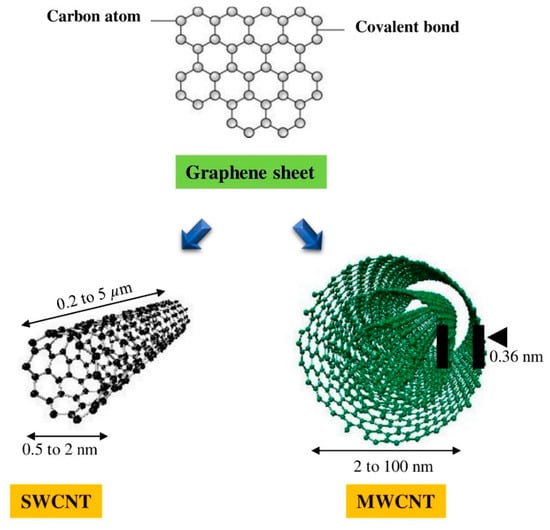
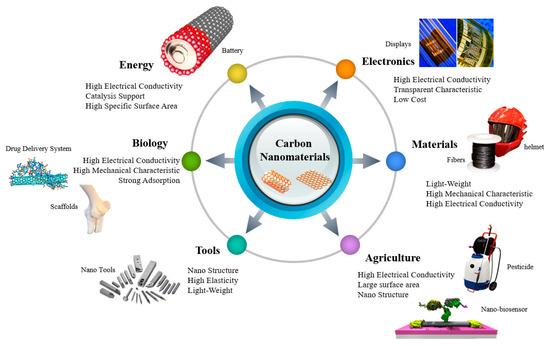
2. Application of CNTs
2.1. Agriculture Applications
2.1.1. CNTs in Plant Growth
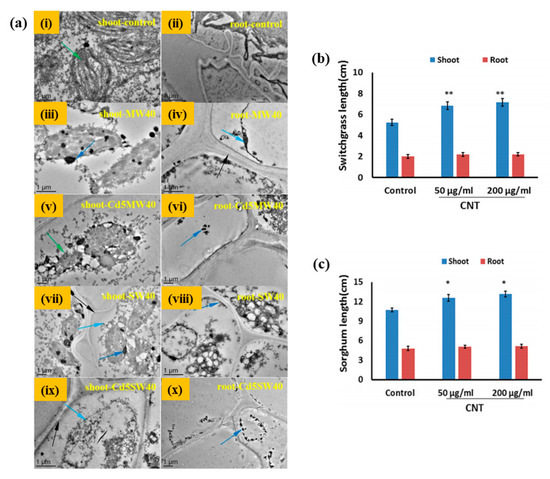
|
Type of CNMs |
Plant |
Treatment |
Effect |
Reference |
|
MWCNTs and oxidized MWCNTs (o-MWCNTs) |
Brassica juncea (mustard) seeds |
23 × 10−3 and 46 × 10−3 mg/mL of MWCNTs for 5 and 10 days and 2.3 × 10−3 and 6.9 × 10−3 mg/mL of o-MWCNTs for 5 and 10 days, respectively |
After 10 days, seedlings treated with low concentration of o-MWCNTs developed the highest shoot (4.2 cm) and root (5.8 cm) length. Seeds treated with a low concentration of MWCNTs also showed shoot about 1.5 times and root about two times longer than original seeds |
[64] |
|
Fullerol and MWCNTs |
Tomato seeds |
50 mg/L and exposure ranged from 0 to 60 minutes (0, 5, 10, 30, or 60 min) |
When exposed for a short period of 5 min, the germination rate was higher than that of the control group and showed no harm to germination |
[65] |
|
Single-walled carbon nanohorns (SWCNHs) |
Barley, Corn, Rice, Soybean, Switchgrass, Tomato |
25, 50, and 100 μg/mL for 2 and 6 days |
The highest germination rate was recorded for barley, corn, rice, and switchgrass seeds exposed to 100 μg/mL SWCNHs and the highest germination rate was observed at 25 μg/mL SWCNHs in tomato seeds |
[66] |
|
MWCNTs |
Broccoli |
10 mg/L MWCNTs, 100 mM NaCl, and 100 mM NaCl + 10 mg/L MWCNTs |
The MWCNTs-treated plants had positive effects on growth compared with the control and NaCl alone application |
[67] |
|
MWCNTs |
Barley, Soybean, Corn |
25, 50, and 100 μg/mL for 2 and 6 days |
After six days, all seeds treated with MWCNT reached a germination rate of 100% compared with control seeds reaching a germination rate of 63% |
[68] |
|
MWCNTs |
Tomato plants |
50 and 200 μg/mL |
The CNT-treated tomato plants produced twice as many flowers as the control plants |
[69] |
|
CNTs |
Rice |
50, 100, and 150 μg/mL |
CNTs at appropriate concentrations (~100 μg/mL) promoted rice seed germination and root growth |
[70] |
|
SWCNTs and functionalized SWCNTs |
Cucumber, Onion |
28, 160, 900, and 5000 mg/L for 2 and 3 days |
Non-functionalized CNTs enhanced root elongation in onion and cucumber, the effects were more pronounced at 24 h than at 48 h |
[71] |
|
SWCNTs (non-functionalized, OH-functionalized, or surfactant stabilized) |
Corn |
0, 10, and 100 mg/kg |
Root length was significantly higher in plants exposed to non-functional SWNT 100 mg/kg and plant root uptake also followed the trend of non-functionalized > surfactant stabilized > OH-functionalized |
[74] |
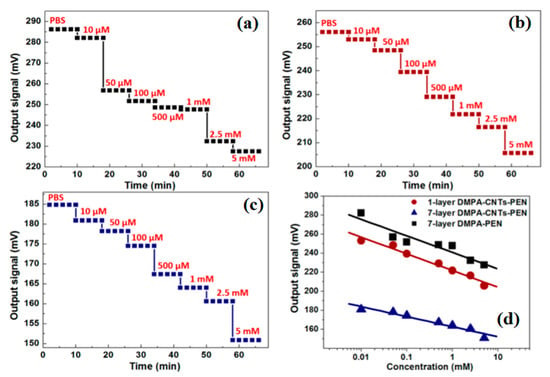
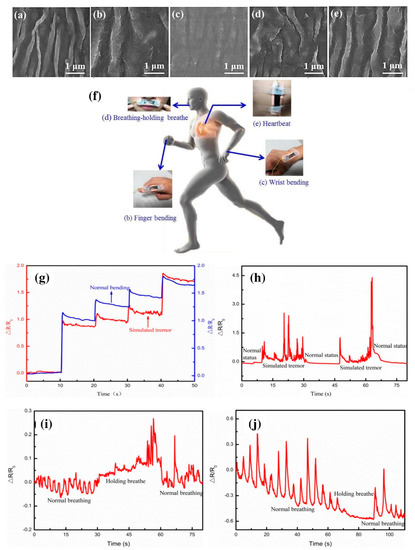
2.1.3. Pesticide Analysis
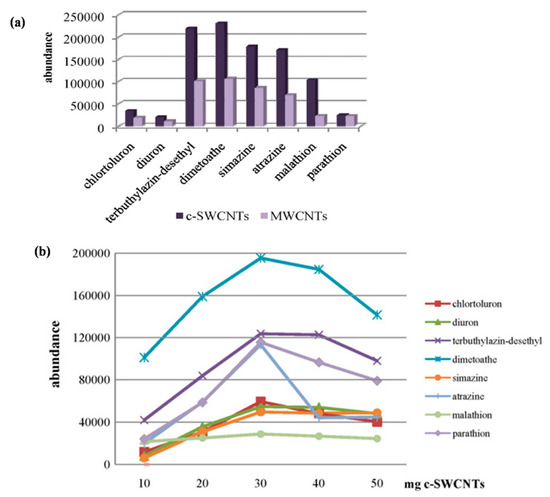
|
CNTs |
Analyte |
Sample |
CNTs amount (mg) |
Recovery (%) |
Reference |
|
MWCNTs |
Disulfoton sulfoxide, ethoprophos, disulfoton, terbufos sulfone, cadusafos, dimethoate, terbufos, chlorpyrifos-methyl, fenitrothion, malaoxon, pirimiphosmethyl, malathion, chlorpyrifos, disulfoton sulfone, and fensulfothion |
Water (run-off, mineral, and tap water) |
130 |
67–107 |
[94] |
|
GO–MCNTs-diethylenetriamine |
Cr(III), Fe(III), Pb(II), and Mn(II) ions |
Wastewater |
30 |
95 |
[95] |
|
MWCNTs |
Organophosphate |
Garlic |
1.2 |
97–104 |
[97] |
|
MWCNTs |
4-Chlorophenol, 3-chlorophenol, dichlorophenol, trichlorophenol, and pentachlorophenol |
River water |
300 |
93–117 |
[98] |
|
MWCNTs |
Tolclofos-methyl, fenitrothin, malathion, phorate, diazinon, isocarbophos, and quinalphos phenamiphos |
Peanut oil |
100 |
86–115 |
[99] |
|
MWCNTs |
Ethoprophos, diazinon, fenitrothion, malathion, and phosmet |
Agricultural soil, forestal soil, and ornamental soil |
100 |
54–91 |
[101] |
|
CNTs |
Analyte |
Sample |
CNTs amount (mg) |
Recovery (%) |
Reference |
|
MWCNTs |
Polybrominated diphenyl ethers (PBDEs) |
River water, waste water, milk |
20 mg |
90–119 |
[102] |
|
SWCNTs |
Ethoprophos, terbufos, thiometon, tefluthrin, iprobenfos, vinclozolin, octachlorodipropyl ether, isofenphos, phenthoate, chlorfenapyr, propiconazol, Ethyl-p-nitrophenylthionobenzenephosphonate (EPN), and λ-cyhalothrin |
Teas (green tea, oolong tea, white tea, and flower tea) |
- |
75–118 |
[103] |
|
SWCNTs |
Hexachlorcyclohexan, dichlorodiphenyldichloroethylene, dichlorodiphenyldichloroethane, and dichlorodiphenyltrichloroethane |
Lake water |
2 g |
88–111 |
[104] |
|
CNTs–silicon dioxide |
Diazinon, fenthion, parathion, and chlorpyrifos |
River water and agricultural wastewater, pear, grape, and eggplant |
50 mg |
79–99 |
[105] |
2.2. Energy and Environmental Applications
4.2.1. Battery
|
CNMs |
Method |
Current Density |
Initial Discharge Capacity (mA·h/g) |
Cycles |
Residual Reversible Capacity (mA·h/g) |
Reference |
|
CNTs–SnSb0.5 |
CVD |
50 mA/g |
549 |
30 |
369 |
[111] |
|
CNTs–LiCoO2 |
CVD |
0.2 C |
118 |
20 |
118 |
[112] |
|
CNTs |
arc discharge |
2 C |
300 |
300 |
255 |
[114] |
|
MWCNTs |
arc discharge |
0.2 mA cm−2 |
117 |
30 |
113 |
[115] |
|
Short CNTs |
CVD |
0.8 mA cm−2 |
491 |
30 |
170 |
[119] |
|
Fe2O3/CNT–graphene foam |
CVD |
200 mA/g |
1190 |
10 |
900 |
[122] |
|
CNTs–cobalt oxide |
|
0.1 C |
1250 |
100 |
530 |
[125] |
|
Zn2SnO4/CNT |
|
100 mA/g |
1925.4 |
30 |
703.8 |
[126] |
2.2.2. Wastewater Treatment
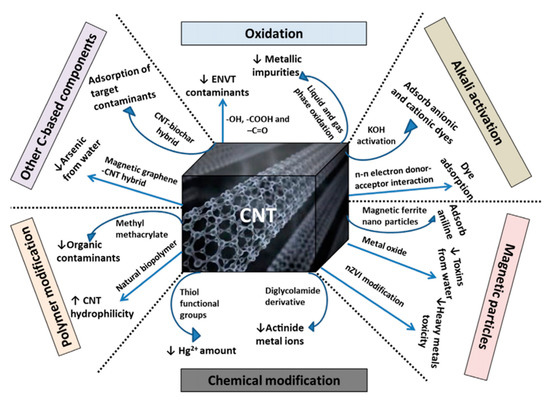
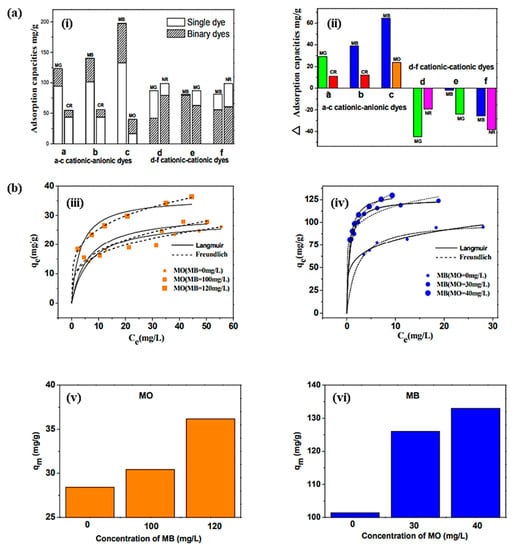
|
Applications |
Desirable Nanomaterials Properties |
Type of CNMs |
Efficiency of the CNMs |
Reference |
|
Catalysts |
Higher catalyst loads and stability, stronger metal–support interactions, high dispersion, high stability and activity, low cost |
Ruthenium/MWCNT-COOH-Na2CO3 |
98.3% and 70.3% aniline and total organic carbon (TOC) removals |
[128] |
|
Ruthenium/MWCNT-COOH |
89.9% and 53.7% aniline and TOC removals |
[128] |
||
|
Mass Transfer |
Facilitate contaminant mass transfer, large surface areas, high electrochemical efficiency, degrade organics with much higher current Efficiency and lower energy consumption |
CNTs |
The efficiency was 340–519% higher than the conventional reactor, and the energy consumption was only 16.5–22.3% of the conventional reactor |
[131] |
|
Adsorption |
Large specific surface areas, high chemical and thermal stabilities, high aspect ratios, exceptional mechanical strength, diverse contaminant–CNT interactions |
SWCNTs, MWCNTs |
The maximum zinc adsorption capacities of SWCNTs and MWCNTs were 43.66 and 32.68 mg/g, respectively, in the initial zinc ion concentration range (10–80 mg/L) |
[134] |
|
Flocculation |
Exceptional adsorption capabilities and efficiencies, larger surface area, affinity towards target compounds |
CNTs |
Demonstrated the ability to successfully coagulate colloidal particles in the brewery wastewater |
[135] |
|
Electrode |
Effective compound adsorption and oxidation, high energy efficiency, fast reaction rate, electrochemical oxidation |
Ti/SnO2-Sb-CNT electrode |
80.12% and 46.01% COD and TOC removals |
[136] |
2.2.3. Microbial Fuel Cells (MFCs)
|
Type of electrode |
MFCs |
Type of MFCs |
Effect |
Power Density (Max.) mW/m |
Reference |
|
|
Anode |
Cathode |
|||||
|
Graphite fiber |
Carbon nanotube/Pt |
Effluent from an air-cathode MFC |
Single chamber MFCs |
The cathode had a maximum power density of about two times higher than that of the carbon cloth cathode |
329 |
[144] |
|
Carbon paper |
CNTs/ Poly-pyrrole |
Anaerobic digester sludge collected from Indah Water Konsortium treated Palm oil mill effluent (POME) |
Two cubic shaped chambers |
COD removal of the system using CNT/PPy was 96% |
113.5 |
[145] |
|
Carbon cloth |
N-CNTs on carbon cloth |
Acetate-laden synthetic wastewater |
Air-cathode cylindrical-shaped MFCs, dual chamber |
The maximum power density was about 9% higher than that of Pt-carbon on carbon cloth |
135 |
[147] |
|
Carbon paper |
CNTs/Pt |
Palm oil mill effluent (POME- Selangor, Malaysia) sludge |
Two cylindrical H-shaped chambers |
The composite electrode increased the power output of MFC by 8.7~32% compared with Pt electrode |
169.7 |
[149] |
|
Carbon paper |
Chemically activated carbon nanofibers |
Palm oil mill effluent (POME) anaerobic (Selangor, Malaysia) sludge |
Two cylindrical and H-shaped chambers |
COD removal was approximately 82.3% and could generate up to 3.17 times more power than carbon paper |
61.3 |
[150] |
|
Carbon fiber |
Nitrogen-doped CNTs (N-CNTs) |
20% domestic wastewater collected from a municipal wastewater treatment plant of Shanghai, China |
Air-cathode single chamber MFCs |
The power density drop rate was low, so electricity can be produced more permanently than the platinum catalyst |
1600 ± 50 |
[151] |
|
MWCNT/ rGO-biofilm |
carbon fiber brush |
S. putrefaciens CN32 cell suspension was inoculated on bacteria |
H-type dual-chamber |
Composite electrodes provide higher maximum power density than individual MWCNTs and rGO |
789 |
[152] |
|
Vertically Aligned CNTs |
Cr/Au film |
Acetate-fed microbial electrolytic cells (MEC) with Geobacter-enriched bacterial community from anaerobic digestion sludge Dual chamber MFCs; anode and cathode chambers |
61.3% of Coulombic efficiency |
270 |
[153] |
|
|
Randomly Aligned CNTs |
Cr/Au film |
73% of Coulombic efficiency |
540 |
|||
|
Spin/spray layer-by-layer CNTs |
Cr/Au film |
73% of Coulombic efficiency |
540 |
|||
|
CNTs/polyaniline (PANI) |
Pt |
Bacteria |
E. coli-based MFCs |
Composite electrodes containing 20 wt.% CNTs provide high discharge performance and high power output |
42 |
[154] |
|
CNTs |
CNTs/Pt |
Bacteria |
Air-cathode MFCs |
COD removal was 95% and the maximum coulombic efficiency was 67% |
65 |
[155] |
|
rGO-CNT sponges |
- |
Anaerobic sludge |
Aerobic chamber and anoxic chamber |
Produced higher durability |
Max. current density of 335 A m−3 |
[156] |
2.2.4. High-Efficiency Electrical Devices
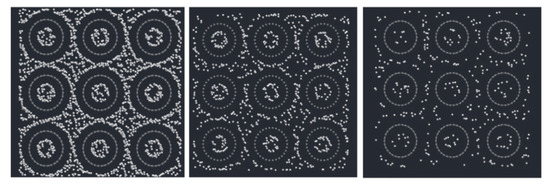
|
CNMs |
Storage (wt.%) |
Temperature (K) |
Pressure (MPa) |
Reference |
|
|
CNTs |
9.6 |
77 |
10 |
[159] |
|
|
CNTs |
1.5 |
296 |
12.5 |
[160] |
|
|
SWCNTs |
4.5 |
77 |
6 |
[161] |
|
|
Chemically activated carbon |
5.6 |
77 |
4 |
[162] |
|
|
Carbon with boron |
5.9 |
298 |
10 |
[163] |
|
|
SWCNTs |
1.73 |
77 |
10 |
[164] |
|
|
SWCNTs-SnO2 |
2.4 |
623 |
5 |
[165] |
|
|
Si-doped SWCNTs |
2.5 |
298 |
10 |
[166] |
|
|
Un-doped SWCNTs |
1.4 |
298 |
10 |
||
3. Conclusions
This entry is adapted from the peer-reviewed paper 10.3390/ma13071679
